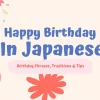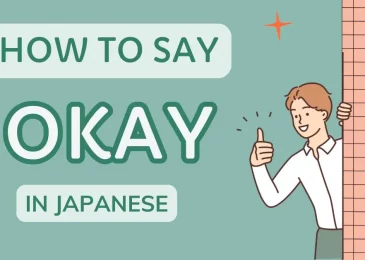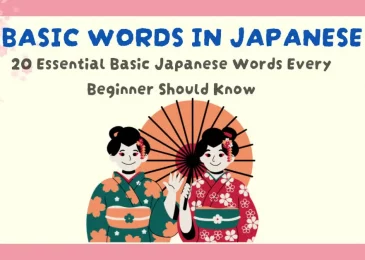The importance of Japanese greetings
Greetings are a fundamental part of any language and culture, serving as the gateway to conversation and connection. In Japanese, the way you say “hello” varies depending on the context, formality, and the time of day. This diversity reflects the richness of Japanese culture and the importance placed on politeness and respect. In this article, we will explore how to say “hello” in Japanese and introduce you to more than ten common greeting phrases that will enrich your interactions. Whether you’re a beginner or looking to refine your skills, these phrases will help you navigate social situations with confidence.
How to say “hello” in basic Japanese?
In Japanese, greetings are not just a way to say “hello” but also convey respect and understanding of social nuances. The way you greet someone can depend on several factors, including the time of day, your relationship with the person, and the level of formality required in the situation.
The most common and widely recognized way to say “hello” in a polite and neutral context is “konnichiwa” (こんにちは). This greeting is generally used from late morning to early evening and is appropriate for most situations, whether you are meeting a friend, a colleague, or someone you don’t know well.
15+ Common Japanese greetings
1. Konnichiwa (こんにちは)
“Konnichiwa” is the standard way to say “hello” in Japanese, especially during the afternoon. This is a neutral, polite greeting that people widely accept in both casual and formal settings, which makes it very versatile. People often use it after around 10 a.m., but it works throughout the day if no specific time-based greeting is needed. You can use ‘Konnichiwa’ with strangers, acquaintances, and in most everyday situations.
2. Ohayou (おはよう)
“Ohayou” is the informal way to say “good morning.” It’s mainly used with friends, family, or people you’re familiar with. This greeting has a warm and friendly tone, perfect for casual conversations. Using “ohayou” in the morning creates a friendly, approachable vibe, and it’s suitable before around 10 a.m.
3. Ohayou Gozaimasu (おはようございます)
Adding “gozaimasu” makes “ohayou” a polite “good morning.” People often use this greeting in formal or professional settings, such as at work or with people they aren’t very close to. ‘Ohayou gozaimasu’ shows respect and politeness, which is appreciated in Japanese workplaces and with superiors or elders. This greeting is also commonly used when entering workplaces in the morning.
4. Konbanwa (こんばんは)
People use ‘Konbanwa’ as a greeting in the evening, similar to ‘good evening.’ This greeting is usually appropriate after sunset and can be used in both casual and formal contexts. It’s polite enough for most situations, making it a safe choice for greeting someone at night.
5. Hajimemashite (はじめまして)
People use ‘Hajimemashite’ to mean ‘nice to meet you’ when meeting someone for the first time. They commonly pair this greeting with a bow as a sign of respect. “Hajimemashite” has a polite and respectful tone, suitable for all situations when introducing yourself. You might say, “Hajimemashite, watashi wa [name] desu,” to introduce yourself formally.
6. Doumo (どうも)
“Doumo” is a casual, flexible greeting that can mean “hi” or “thanks” depending on the context. When used as a greeting, it’s an informal way to say “hello,” often in passing or when casually acknowledging someone. It can also serve as a quick, friendly response or casual acknowledgment when you don’t need a full conversation.
7. Moshi Moshi (もしもし)
“Moshi Moshi” is exclusively used when answering the phone, serving as the equivalent of “hello” on a call. It’s informal and generally used with friends, family, or people you’re familiar with. “Moshi Moshi” is typically the first word spoken on a phone call, creating an approachable and friendly tone. Avoid using it in formal situations or when answering a business call.
8. Genki? (元気?)
“Genki?” is a casual way to ask, “How are you?” or “Are you well?” It’s informal and usually exchanged between friends or family. It conveys a friendly, caring tone, ideal for informal settings. If you want to make it more polite, you can say “Ogenki desu ka?” (お元気ですか), which is suitable for acquaintances or formal conversations.
9. Yaa/You (やあ/よう)
People use “Yaa” and “You” as informal ways to say “hi,” generally between close friends. These greetings carry a relaxed, easygoing tone and are casual and friendly. They often associate with younger people or situations where the atmosphere is lighthearted and familiar. People should avoid using them in formal or professional settings.
10. Yahho (やっほー)
“Yahoo” is a playful and informal “hey” that’s popular among younger people or close friends. It’s often used by women or children and has a cheerful, friendly vibe. “Yahoo” is ideal for situations where you’re excited to see someone or want to create a warm, friendly atmosphere. Like “Yaa” and “You,” it’s best saved for informal interactions.
11. Ikaga Desuka? (いかがですか?)
“Ikaga desuka?” is a polite way to ask, “How’s it going?” or “How are you?” This greeting is commonly used in formal situations or with people you’re not very close to, showing respect and politeness. It’s suitable for work settings, meetings, and when addressing elders. It conveys genuine concern for the other person’s well-being in a respectful tone.
12. Irasshaimase (いらっしゃいませ)
Shop, restaurant, and business staff use the greeting “Irasshaimase,” which means “welcome,” to greet customers in a friendly, respectful, and formal manner. This greeting is not intended to start a conversation but rather to make customers feel welcome as they enter the establishment. It’s specific to service settings and not used in personal interactions.
13. Tadaima (ただいま)
“Tadaima” means “I’m back” and is typically used when you return home. It’s informal and commonly exchanged within families or close relationships. When you say “tadaima,” it’s usually followed by “okaeri” from someone at home, which means “welcome back.” This greeting carries a warm, familiar tone and is part of Japanese homecoming rituals.
14. Okaeri (おかえり)
“Okaeri” or “Okaerinasai” (おかえりなさい) means “welcome back” and is the response to “tadaima.” It’s informal and mostly used within families or with close friends. “Okaeri” has a warm and welcoming tone, often creating a sense of comfort and familiarity. Saying “okaeri” shows appreciation and happiness for the person’s safe return home.
15. Otsukaresama (お疲れ様)
People commonly use Otsukaresama among coworkers in workplaces to say ‘thank you for your hard work’ or ‘you must be tired.’ This polite expression shows appreciation for someone’s efforts and is often said at the end of the workday. “Otsukaresama deshita” (お疲れ様でした) is the more formal version and is suitable for superiors or older colleagues. This greeting acknowledges the efforts someone has put in, creating a respectful and appreciative atmosphere.
Learn Japanese greetings with MochiKanji

MochiKanji is an exceptional tool for mastering essential Japanese phrases through engaging conversation practice. Interacting with characters Mochi and Michi enhances your learning experience, helping you apply common phrases in real-life contexts. Whether you’re learning greetings or travel expressions, MochiKanji makes mastering Japanese enjoyable. The app features interactive flashcards enriched with images and sounds, alongside a spaced repetition system that, paired with the latest Golden Time feature, optimizes your review sessions for better retention.
Japanese greetings for specific situations
Common daily greetings in Japanese
For a good morning greeting:
- To elders and superiors: おはようございます (Ohayou gozaimasu)
- To family and friends: おはよう (Ohayou)
When greeting in the afternoon: こんにちは (Konnichiwa)
For a good evening greeting: こんばんは (Konbanwa)
Greeting when meeting for the first time:
- はじめまして (Hajimemashite) – Nice to meet you
- こんにちは (Konnichiwa) – Hello (In everyday conversation, Japanese people often just use はじめまして (Hajimemashite) for a more natural feel.)
Goodbye:
- じゃ、また (Ja, mata) – Goodbye (See you later) – また + time will meet again (…let’s meet again)
- さようなら (Sayounara) – Goodbye (used when you won’t see someone for a long time)
- また会いましょう (Mata aimashou) – Let’s meet again another time
- おやすみなさい (Oyasuminasai) – Good night (goodbye, wishing you a good sleep)
Greetings in the Workplace: With superiors and colleagues
Upon arriving at the Office:
- おはようございます (Ohayou gozaimasu) – Good morning
- こんにちは (Konnichiwa) – Good afternoon
- こんばんは (Konbanwa) – Good evening
When leaving work:
- お先に失礼します (Osaki ni shitsurei shimasu) – Excuse me for leaving early. (You use this when you are leaving the office, and your colleagues are still working.)
- お疲れ様でした / お先に失礼します (Otsukaresama deshita / Osaki ni shitsurei shimasu) – Thank you for your hard work; I’m leaving early (more polite).
- お疲れ様でした (Otsukaresama deshita) – You have worked hard. This is a response to someone’s earlier goodbye.
- ご苦労様でした (Gokurousama deshita) – Thank you for your efforts. This is equivalent to お疲れ様でした (Otsukaresama deshita) and is used to show appreciation.
Going outside:
- 行ってまいります (Itte mairimasu) – Excuse me, I’m going out.
Coming back inside:
- ただいま戻りました (Tadaima modorimashita) – I’m back.
When entering another room:
- 失礼いたします (Shitsurei itashimasu) – Excuse me!
Leaving a room:
- 失礼いたしました (Shitsurei itashimashita) – I apologize for the interruption.
When a colleague goes outside:
- いってらっしゃい (Itterasshai) – Take care!
When a colleague comes back:
- おかえりなさい (Okaerinasai) – Welcome back!
Passing colleagues:
- お疲れ様です (Otsukaresama desu) こんにちは (Konnichiwa) – Thank you for your hard work. Hello!
Phone greetings in Japanese
Common phone greetings:
- もしもし (Moshi moshi) – Hello (used on the phone)
- もしもし、私は…と申します (Moshi moshi, watashi wa … to moushimasu) – Hello, I am…
- お電話、大丈夫ですか (Odenwa, daijoubu desu ka?) – Is it a good time to talk?
When calling a business partner:
- いつもお世話になります (Itsumo osewa ni narimasu): Thank you for your help
- いつもお世話になっております (Itsumo osewa ni natte orimasu): Thank you for your continued support
Greeting someone you haven’t seen in a while
- 久しぶりですね (Hisashiburi desu ne) – It’s been a long time since we last met!
- お久しぶりですね (Ohisashiburi desu ne) – It’s been a while since we last met.
- ご無沙汰しております (Gobusata shite orimasu) – I haven’t visited in a long time.
- 久しぶり (Hisashiburi) – Long time no see.
- ご無沙汰いたしまして、申し訳ありませんでした (Gobusata itashimashite, moushiwake arimasen deshita) – I’m really sorry for not visiting for such a long time.
Business greetings when meeting partners
When Meeting Partners:
- お会いできて光栄です (Oai dekite kouei desu) – It’s an honor to meet you.
- このような機会をいただけて光栄です (Kono youna kikai wo itadakete kouei desu) – I’m honored to have this opportunity.
In Restaurants:
- いらっしゃいませ (Irasshaimase) – Welcome!
In Bars:
- 何にしましょう (Nani ni shimashou) – What would you like?
Japanese greeting culture
1. The bowing greeting of the Japanese
Bowing in Japanese culture is simply a way to show respect to others, typically towards someone older or in a higher position. In situations where there is a significant age difference or in formal public settings, people reserve bowing among friends. Instead, among friends, waving is becoming more familiar and common in Japanese greeting culture.
How is the Japanese greeting culture?
Japanese people often bow while saying familiar phrases like “Ohayou Gozaimasu” (Good morning) or “Ohayou” (Hello), and “Arigatou” (Thank you). They usually say these greetings after completing the bow.
Learn more about how to say hello in Japanese HERE.
2. The posture of greeting in Japanese culture
Posture is a very important aspect of bowing in Japan. When bowing, it is crucial to bend from the waist and maintain a straight posture with your knees together.
When interacting with Japanese people, you should also bow your head when someone bows to you. People see this as a sign of politeness, unless they hold a significantly higher position or are older than the other person. Japanese people use different types of bows based on the situation, including:
- ESHAKU (会釈) – A light bow
Eshaku is a greeting style used for people of the same age, social class, and status, reflecting intimacy and a light touch. In this type of greeting, the upper body bows slightly, about 15 degrees, for one to two seconds, with hands resting at the sides.
People also use eshaku as the most common greeting in daily interactions, and it is the simplest. Japanese people usually bow formally only during the first meeting of the day; for subsequent meetings, they typically bow lightly.
- KEIREI (敬礼) – A Standard Bow
Keirei is a greeting style that conveys a higher level of formality compared to Eshaku. People use keirei in greetings to superiors, elders, or customers and business partners.
In this bow, the Japanese bend forward from 30 to 35 degrees for about two to three seconds. If you are sitting on the floor and want to perform this bow, your ears should touch the ground, spaced about 10 to 20 cm apart, with the distance from your head to the floor when bowing kept at about 10 to 15 cm.
- SAIKEIREI (最敬礼) – The most formal bow
The Saikeirei bow represents the highest level of respect towards others, expressing gratitude and reverence towards deities, Buddha, God, national flags, or towards ancestors such as grandparents and parents.
In this formal greeting, the Japanese bow very low, at about 45 to 60 degrees, and hold this position for about three seconds or even longer.
Conclusion
Mastering the various ways to greet someone in Japanese is essential for effective communication and shows respect for cultural norms. From formal greetings to casual expressions, understanding these phrases can greatly enhance your conversations and relationships in Japan. As you practice these common greetings, remember that language is not just about words; it’s about connection and understanding. Embrace the beauty of the Japanese language and culture as you incorporate these greetings into your daily interactions.









